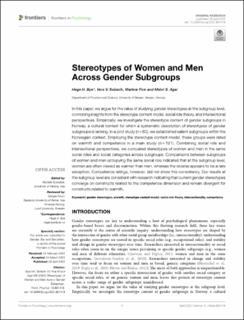| dc.contributor.author | Bye, Hege Høivik | |
| dc.contributor.author | Solianik, Vera S. | |
| dc.contributor.author | Five, Martine | |
| dc.contributor.author | Agai, Mehri Shekh | |
| dc.date.accessioned | 2022-09-27T11:44:20Z | |
| dc.date.available | 2022-09-27T11:44:20Z | |
| dc.date.created | 2022-09-26T11:43:04Z | |
| dc.date.issued | 2022 | |
| dc.identifier.issn | 1664-1078 | |
| dc.identifier.uri | https://hdl.handle.net/11250/3021767 | |
| dc.description.abstract | In this paper, we argue for the value of studying gender stereotypes at the subgroup level, combining insights from the stereotype content model, social role theory, and intersectional perspectives. Empirically, we investigate the stereotype content of gender subgroups in Norway, a cultural context for which a systematic description of stereotypes of gender subgroups is lacking. In a pilot study (n = 60), we established salient subgroups within the Norwegian context. Employing the stereotype content model, these groups were rated on warmth and competence in a main study (n = 191). Combining social role and intersectional perspectives, we compared stereotypes of women and men in the same social roles and social categories across subgroups. Comparisons between subgroups of women and men occupying the same social role indicated that at the subgroup level, women are often viewed as warmer than men, whereas the reverse appears to be a rare exception. Competence ratings, however, did not show this consistency. Our results at the subgroup level are consistent with research indicating that current gender stereotypes converge on constructs related to the competence dimension and remain divergent for constructs related to warmth. | en_US |
| dc.language.iso | eng | en_US |
| dc.publisher | Frontiers | en_US |
| dc.rights | Navngivelse 4.0 Internasjonal | * |
| dc.rights.uri | http://creativecommons.org/licenses/by/4.0/deed.no | * |
| dc.title | Stereotypes of Women and Men Across Gender Subgroups | en_US |
| dc.type | Journal article | en_US |
| dc.type | Peer reviewed | en_US |
| dc.description.version | publishedVersion | en_US |
| dc.rights.holder | Copyright 2022 The Author(s) | en_US |
| dc.source.articlenumber | 881418 | en_US |
| cristin.ispublished | true | |
| cristin.fulltext | original | |
| cristin.qualitycode | 1 | |
| dc.identifier.doi | 10.3389/fpsyg.2022.881418 | |
| dc.identifier.cristin | 2055377 | |
| dc.source.journal | Frontiers in Psychology | en_US |
| dc.identifier.citation | Frontiers in Psychology. 2022, 13, 881418. | en_US |
| dc.source.volume | 13 | en_US |

